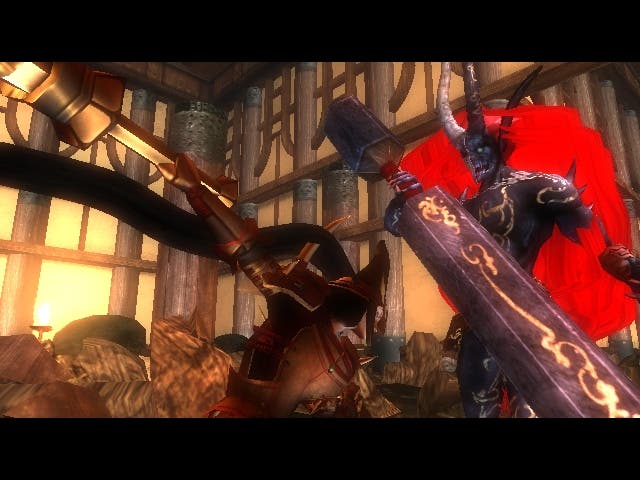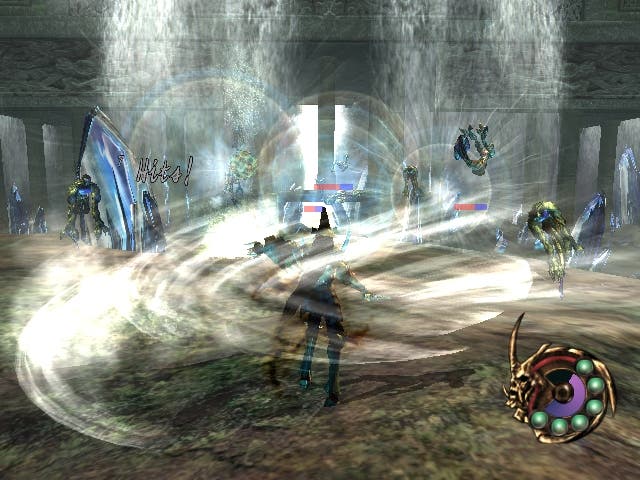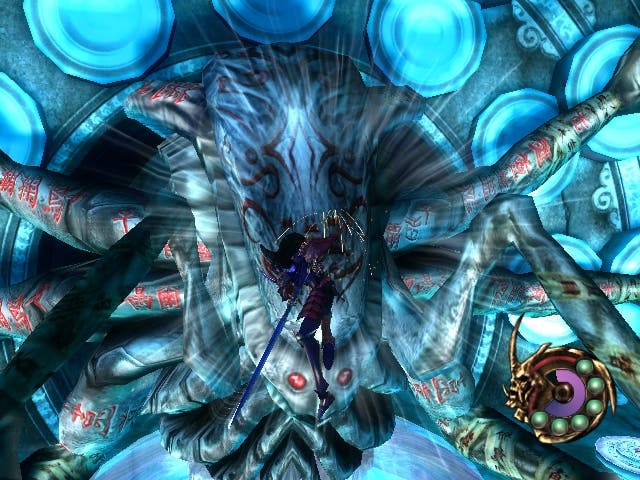Otogi - Myth of Demons
Tom experiences grace for the first time.
Way back when us Western yokels were busy clobbering one another with sticks and scrawling crude pornography on cave walls, the Japanese were busy slaying demons and crooked old men with very dodgy beards. Bless 'em. But although good generally triumphs over evil, there was plenty of evil doing the rounds, and it didn't take much to plunge Japan - not to mention the rest of the world - into perpetual darkness, the likes of which neither sun nor moon could penetrate.
Fortunately, spiritual folks were busy looking out for us even from beyond the grave. When all seemed lost, vaporous spirit ladies were busy resurrecting misguided ninjas like Raikoh, the anti-hero of this tale, who is promised deliverance to the afterlife on the condition that he purifies the Earth of its recently installed demonic overlords. Hang on, do what? Oh well, anything's better than an eternity as dust, right? Right!
Can I help you, Myth?

Having fallen down the couch between the cushions of existence, Raikoh is only too happy to lend a hand, and so his spiritual guide pops him into various hellspawn hotspots which are in serious need of cleansing. To give him the upper hand, he's imbued with all sorts of powers, like the ability to gradually heal himself, dish out a range of otherworldly magic, and move like a bullet between locations to outfox clumsy demonic scum.
You control Raikoh with the four main function buttons (A for jump/double jump, B and Y for light and heavy attacks, X to fire on whichever magical attack you have equipped) and triggers (left to lock onto an enemy, right used with a directional movement to dash around) - a simple arrangement which takes virtually no getting used to, and you go around quite simply smashing everything to bits with your swords and sorcery.
The simple control scheme is hugely versatile, allowing you to pirouette on land, sea and in the air, dancing around the landscape and ploughing it up by sending demons flying through wood, masonry and foliage on the end of your katana. It's a very satisfying quasi-life, neatly paced and focused on doing damage - lots of damage. Each stage lasts only a few minutes, but afterwards you're ranked by the percentage of enemies killed, how much of the environment you managed to level, and how stylishly you dispatched the bad guys. [Very Devil May Cry - Ed]
Dust off

What you quickly learn is that physical vitality is less important than the state of your magical reserve, metered in the bottom right of the screen, which goes down with every dash or spell and goes up with every swipe of the sword and vanishing nasty - each of which is nice enough to deposit its soul fresh for a bit of Onimusha-style harvesting. If you run out of magic, you run out of existence, frothing into dust like the Wicked Witch of the West at a wet T-shirt contest, so it's a good idea to keep fighting.
Magic isn't immediately available though, and you'll have to hold the X button down for a bit to unleash a truly powerful attack, so for day-to-day demon slaying your best bet is whichever heinous bit of metallic weaponry happens to be resident at the end of your arm. As you work your way through the game, you can buy new weapons from a Shop (don't ask us where it came from), with everything from humble katanas and broadswords to double-headed battleaxes, and by mashing away at the B and Y buttons whilst dashing and leaping away from projectile attacks, you'll be able to cut demons up a treat and send them hurtling into the scenery - most of which is destructible.
And we don't simply mean the odd wishing well or stick of bamboo, either. Most of the game can be destroyed by hacking away at it, from walls and bridges to pillars and hulking great staircases, but the most satisfying destruction in Otogi is wrought by smashing enemies into things. Jumping around and swishing your blade from side to side looks nice, but any burgeoning hackandslash apathy is quickly tempered by the sight of a screaming demon cleaving a temple in two and vanishing in a cloud of dust and splinters.
Creature feature

From what we've seen, it's a good thing there's an unusual level of destruction at work, because although entertaining, Otogi is quite repetitive. Most missions involve "purifying" an area of its demon squatters, from flying skeleton warriors and flame-spitting gargoyles to floating heads and poisonous plant life, while a few hinge on objectives like breaking a handful of demon-spewing mirrors (their words). Meanwhile, the boss battles interspersing the run of the mill slaughter are nicely realised and set on an impressive scale.
From Software has also built in a nice range of elemental upgrades. There are four schools of magic to master, each of which can be upgraded a few times in-game or via the Shop, and these usher forth fiery red phoenixes, purple dragons, bolts of lightning and even swarms of deadly butterflies (deadly as in spiked-moth-on-a-rod in A View To A Kill). The Shop also plays host to various amulets and accessories, which boost Raikoh's powers.
Perhaps cleverly, each weapon and accessory has a certain weight, so whilst tooling the poor chap up with all manner of items might seem like a plan, it can mean the difference between dashing away and catching the end of a fireball in combat. As such, it's a good idea to scout your opposition on the detailed creature pages offered before each mission and think a bit before throwing on your battle armour.
You need a slash
The whole of the game is sewn together with some sharp, smooth visuals and typically Japanese-y presentation. The menus have odd-looking symbols, flowing tapestries and things like that and the music is dainty and soothing - even in the midst of battle. The graphics could do with a bit of variation, as we're mostly dealing with greys, browns and splatters of magical colour, but the game is set under the veil of eternal darkness so you can understand From's choice of palette. Nevertheless, when light does come into play it's nicely realised, with some soft flare playing on the camera and accentuating Raikoh's graceful animation rather nicely. For a dead chap, he certainly keeps himself in shape.
Certainly, the Otogi code we've been playing seems pretty much finished, with very few gaping seams the likes of which plague most preview releases, so we're pretty confident this one will be out before the end of the year as planned. And although we have some lingering doubts about the camera and longevity, we're looking forward to playing it again. Wiz ziz graceful swordplay and ceaseless combat, Sega still knows how to push our buttons.

